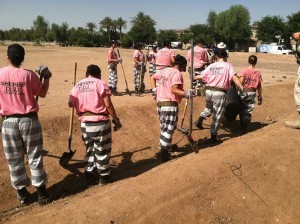 On assignment out here in Arizona, I’m led to compare it to my adopted state of New York. First, there’s the weather: no snow, warm temps, bicycle-friendly year-round. Out here, of course, that’s a normal winter.
On assignment out here in Arizona, I’m led to compare it to my adopted state of New York. First, there’s the weather: no snow, warm temps, bicycle-friendly year-round. Out here, of course, that’s a normal winter.
The big city dominates state politics. Here the city is Phoenix. With two-thirds of the state’s population, the Phoenix metro area carries a big stick. Arizonans living elsewhere complain that they have but a small, quiet voice in state political circles and that the interests of Maricopa County (Phoenix, Tempe, Scottsdale, etc.) rule. We’ve got our big city, of course: New York City alone accounts for just over 40 percent of the state’s population. Add in Long Island and Westchester and Rockland counties, and metro New York’s share rises to 61 percent.
Both “big cities” have a dominant political culture, too. By registration, Phoenix metro Republicans outnumber Democrats by about 30 percent. New York is, of course, dominated by Democrats, but by a whopping 6-to-1 ratio, an advantage unimaginable among Maricopa County Republicans.
And just as Upstate New York Republicans fret about Democratic policy and influence in Albany, many in Democrat-dominated Tucson are quick to tell you that those “crazy people in Phoenix” don’t represent them. In Tucson’s Pima County, Democrats outnumber Republicans by about 20 percent. In Santa Cruz County, host to the busy Nogales port of entry to Mexico, Republicans are outnumbered 3-to-1.
Both Arizona and New York are big states with far-flung outposts. The Center for Governmental Research project that brings me here requires a meeting in Yuma. A 240-mile journey from Tucson, the trip resembles a recent expedition I made to Malone in Franklin County, 243 miles from Rochester. In both cases, the distant locale is separated by a physical barrier; in Arizona, it’s the Sonoran Desert. Franklin County is cut off from the rest of the state by the Adirondacks. And both distant regions fret about relevance.
Both states have an international border. Judged solely by the Phoenix-dominated media reports, we might think that all Arizonans view the border with fear and dislike. And that would be a mistake. Just like New York’s border counties to the west and north, Arizona’s southern counties find the border an economic and cultural bonanza. Residents of Nogales, Ariz., speak fondly of days when the border was a line on the map and a small sign in the street. Festival bands flowed freely back and forth. A 2008 study by the University of Arizona found that Mexican shoppers spend about $2.8 billion in Arizona every year and that this number has been growing over time. In 2010, the value of imports and exports flowing through Arizona ports of entry totaled $16 billion and $10 billion, respectively. About three-quarters of this trade flows through Nogales.
On a previous visit I was given a tour of Nogales, Sonora, and saw firsthand the large and vibrant industrial activity just south of the border. Nogales has avoided the drug-related violence of other Mexican border cities, preserving more of the tourist trade. On balance, this binational region creates significant value for Arizona and its residents. Many resent the national focus on “hardening the border,” since it has reduced cultural exchange and made simple trade more difficult.
Both states are influenced by domestic migration. Looking at 2000-08, the period before the Great Recession, New York lost 1.6 million residents (8 percent of its population) to other states, the largest absolute and relative loss in the nation. Arizona, by contrast, was a close second to Nevada in being the largest “receiver” states, and it added more than 700,000 people who moved from other states, about 14 percent of its 2000 population. FYI, Florida was first numerically, adding 1.3 million, about 8 percent of its population. I think we know where lots of those New Yorkers went.
There are social implications of such migration, of course. Only 36 percent of current Arizona residents–versus 64 percent of New Yorkers–were born in the state. I don’t know how this influences politics and the social dynamic, but it must be significant.
And, of course, we both have famous sheriffs. Until his fall from grace, we had the Sheriff of Wall Street, Eliot Spitzer. Arizona has Maricopa County Sheriff Joe Arpaio, the guy who brought chain gangs in striped jumpsuits back to America.
I’ve seen them out here, incidentally-groups of prisoners picking up roadside litter while managing the chains that connect them to one another. Now Sheriff Joe has announced that he has evidence challenging the validity of Barack Obama’s citizenship. It’s not quite Spitzer’s campaign against the head of the New York Stock Exchange, but big personalities take on big challenges.
We’ve got more in common with Arizona than you might think, and certainly our struggles with representative democracy aren’t unique. Where we stand is ever influenced by where we sit–and whether we find ourselves in the majority or minority.
